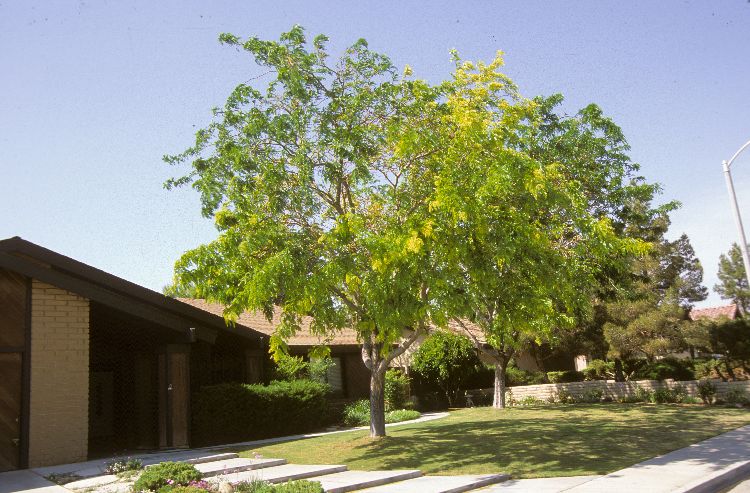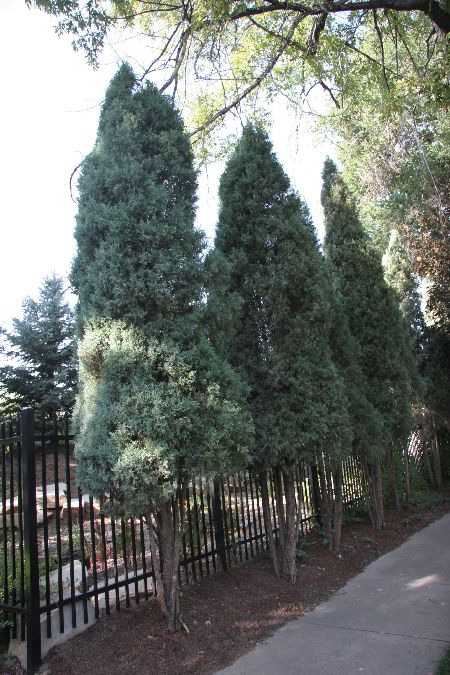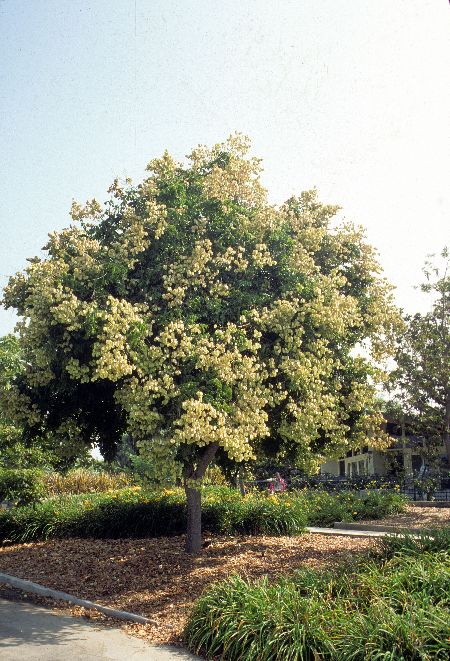Crataegus laevigata 'Crimson Cloud'
Crimson Cloud Hawthorn
Consider 'Crimson Cloud' a small tree with a big payoff. Profuse numbers of small fragrant flowers, bright red with a white center, bloom in midspring. Shiny red berries follow in the fall that are loved by birds. Form is rounded with somewhat thorny branches. Yellow fall color. It can be susceptible to diseases, including hawthorn leaf blight and fungus. Canopy coverage: 314 square feet. Photos courtesy Ruth Quade.
[Read More]Crataegus phaenopyrum
Washington Hawthorn
Considered one of the best Hawthorns, Washington Hawthorn provides interest throughout the year. It has a graceful form with a dense, upright growth habit. Expect brilliant fall color in shades of orange, scarlet and purple. Accepts sandy to heavy clay soils. Canopy coverage: 314 square feet.
[Read More]Euonymus alatus
Burning Bush
Burning Bush is most commonly grown as a large, dense, rounded shrub, but it can be trained to become a small tree. Appealing features include brilliant red fall color and cork-textured "wings" on the stems. Improved selections are available. Canopy coverage: 113 square feet.
[Read More]Forestiera neomexicana
Desert Olive
Train Desert Olive as a small tree or shrub. Appealing features include the light gray bark, which contrasts nicely with its bright green leaves. Attractive yellow fall color. Canopy coverage: 50 square feet.
[Read More]Frangula alnus 'Columnaris'
Alder Buckthorn
This Buckthorn is most often grown as a vertical shrub. Leaves are glossy on slender branches. Red berries in summer turn black as they age. Canopy coverage: 28 square feet.
[Read More]Ginkgo biloba
Maidenhair Tree
This tree is treasured for its unique, fan-shaped leaves that turn a golden yellow in fall. Choice tree for lawn area. Canopy coverage: 1,257 square feet.
[Read More]
Gleditsia triacanthos inermis
Honey Locust
Upright spreading form helps make this a quality shade tree. Golden yellow fall color. 'Shade Master' is a popular selection. Canopy coverage: 962 square feet.
[Read More]Gymnocladus dioica
Kentucky Coffee Tree
Kentucky Coffee Tree is a large tree with an attractive, open form that is interesting when bare in winter. Flowers on female trees are following by large, heavy seed pods that are a rich, coffee brown color. Can be messy with pods and leaf drop. Adapts to poor soil. Accepts sandy to heavy clay soils. Canopy coverage: 962 square feet.
[Read More]Hibiscus syriacus
Rose of Sharon
When in bloom, Rose of Sharon reminds one of hollyhocks. It can be pruned to suit the needs of the landscape, from small tree to large, natural shrub or screen. Flowers are mostly shades of pink. Leaves have a coarse texture. Best with some protection from the sun in hot summer regions. Canopy coverage: 28 square feet.
[Read More]Juniperus osteosperma
Utah Juniper
Utah juniper can be trained as a tree or large shrub. Despite its common name, it is the most common juniper in Arizona. Accepts dry rocky soils. Canopy coverage: 314 square feet.
[Read More]
Juniperus scopulorum
Rocky Mountain Juniper
Many different selections of Rocky Mountain Juniper are available, with variable forms, textures and foliage color. Look for 'Skyrocket', blue-green foliage; 'Gray Gleam', blue-gray foliage, 'Blue Haven', deep blue-gray foliage; and 'Tolleson's Blue Weeping', drooping form with blue-gray leaves. Canopy coverage: 314 square feet.
[Read More]Juniperus virginiana
Eastern Red Cedar
The typical conical form of Eastern Red Cedar is attractive in the landscape, but as a tree matures its shape becomes more irregular. Foliage color can vary from gray-green to dark green or even light green, then takes on a reddish tint with winter cold. Blue berries appear on female plants. Accepts a wide range of soils. Canopy coverage: 707 square feet.
[Read More]Juniperus virginiana cupressifolia
Hillspire Juniper
Grows in a symmetrical tree with a pyramidal form. Extremely cold hardy. Blue berries appear on female plants. Accepts a wide range of soils. Sometimes sold under the name 'Hillspire'. Canopy coverage: 177 square feet.
[Read More]
Koelreuteria paniculata
Goldenrain Tree
The open, branching form of Goldenrain Tree produces light shade. Papery fruit capsules emerge red then turn brown. Best with some protection from the sun in hot summer regions. Canopy coverage: 962 square feet.
[Read More]Malus 'Indian Magic'
Flowering Crabapple
Hundreds of crabapple varieties are available to choose from. 'Indian Magic' is shown here. Look for those known to do well locally and are disease resistant. Canopy coverage: 177 square feet.
[Read More]Picea abies
Norway Spruce
Norway Spruce is a popular evergreen, often used for windbreaks. It grows at a rapid rate to 60 feet high, sometimes much more. Cones up to 6 inches long are the largest of the Spruces. Form is pyramidal when trees are young, then branches become more horizontal and sometimes droop. 'Pendula', drooping branches shown in photos, has weeping branches that drape downward. It makes an exceptional specimen plant. Accepts sandy to heavy clay soils, and poor soils. Canopy coverage: 707 square feet.
[Read More]Picea engelmannii
Engelmann Spruce
One of the best evergreens for landscape use, Engelmann Spruce does well in lawn conditions. It grows tall, so be sure there is plenty of space above the planting site. It has a dense growth habit. Accepts sandy to heavy clay soils, even poor soils. 'Compacta', blue-green foliage shown in photo, may be a better choice if height is an issue. Canopy coverage: 177 square feet.
[Read More]Picea omorika
Serbian Spruce
Serbian Spruce is an excellent conifer and should be placed at the top of the list for residential landscape use. Form is dense and pyramidal, almost columnar, due to its rather narrow spread. Needles are glossy deep green on top and white underneath. Canopy coverage: 314 square feet.
[Read More]Picea pungens
Colorado Spruce
Colorado Spruce grows as a broad, pyramidal form, with stiff, dense needles that vary from blue-green, dark green and silver. Many improved selections are available. Accepts sandy to heavy clay soils, and poor soils. Canopy coverage: 491 square feet.
[Read More]Picea pungens 'Iseli Fastigiate'
Iseli Fastigiate Colorado Spruce
Similar to Colorado Spruce, this selection grows as a broad, pyramidal form that is more narrow and upright than the species. Accepts sandy to heavy clay soils, and poor soils. Canopy coverage: 79 square feet.
[Read More]
Pinus aristata
Bristlecone Pine
Bristlecone Pine is a Colorado native, well known as being one of the oldest organisms on earth, living more than 4,000 years. They develop into gnarled, twisted specimens in tough locations in the wild. Very slow growing, it becomes a small tree of great character. Prefers low-water locations and must have well drained soil, so keep out of lawn areas. Accepts sandy to heavy clay soils, and poor soils. Canopy coverage: 177 square feet.
[Read More]